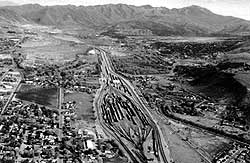Chapter 18:
Introduction
Early Pocatello: The Townsite and the
Indian Reservation
Treaties and Enlargement of Pocatello
Reduction of Area of the Fort Hall
Indian Reservation
Rapid Growth in the 1890's
Southwest is West; Southeast is South
The Legacy of No Urban Planning
Naming the Streets of Downtown
Dusty Streets and a City Divided
Pluralism
The Center Street Viaduct
Congregational Church
St. Joseph's Catholic Church
The Need for Water in a Semi-Desert
City
Pocatello Portrait and the Water System
Droughts and Urban Conflict, 1900s
Style
Establishment of a Public Water System
Water Meters and Annexation of Alameda
Public Water and Growth before World
War I
The Fort Hall Canal
Frank Paradice
The Standrod House
The Carnegie Library
Hydroelectric Power
Floods in the Portneuf Valley
Pocatello: Idaho's Industrial City
Idaho State University
The Future: Pocachub, Pocabuck, Chubpo
or Chubatello
Portneuf Greenway

Sidebars:
The Land Run of 1902
The Bannock Range